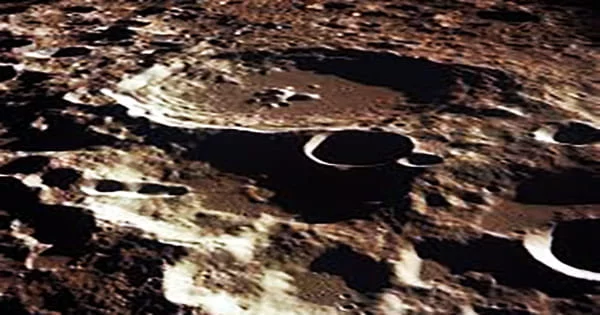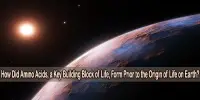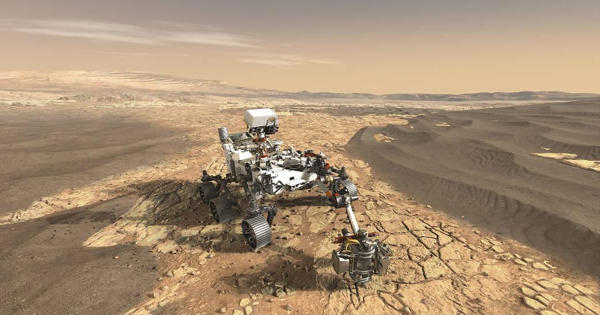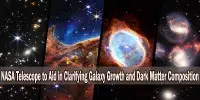The Moon maintains our planet’s axis of rotation steady, which governs seasons and regulates our temperature, making life on Earth possible. However, there has been a lot of discussion about how the Moon was produced. According to common belief, the Moon was formed when a Mars-sized planet collided with Earth’s top crust, which is devoid of metals.
However, a new study reveals that the Moon’s subsurface is more metal-rich than previously assumed, posing fresh questions about how that process works. Many craters dot the Moon’s surface, all of which were produced by impacts. Currently, the International Astronomical Union recognizes 9,137 craters, 1,675 of which have been dated.
A paper published today in the journal Earth and Planetary Science Letters gives fresh information on the makeup of the dust discovered at the bottom of the Moon’s craters. The team members of the Miniature Radio Frequency (Mini-RF) instrument onboard NASA’s Lunar Reconnaissance Orbiter (LRO) mission used radar to image and characterize this fine dust, led by Essam Heggy, research scientist of electrical and computer engineering at the USC Viterbi School of Engineering and co-investigator of the Mini-RF instrument onboard NASA’s Lunar Reconnaissance Orbiter (LRO). The researchers came to the conclusion that the Moon’s subsurface may contain more metals (such as Fe and Ti oxides) than previously thought.

The fine dust in the bottom of the Moon’s craters, according to the researchers, is really ejected materials driven up from beneath the Moon’s surface during meteor strikes. When the researchers compared the metal content at the bottom of larger and deeper craters to that of smaller and shallower ones, they discovered that the deeper craters had greater metal concentrations.
There is little erosion on the Moon because to its absence of water, atmosphere, and tectonic plates, and craters dating back over two billion years have been discovered. The amount of smaller craters contained within a major crater determines its age, with older craters accumulating more small, contained craters.
What does a change in recorded metal presence in the subsurface have to do with our understanding of the Moon? The conventional theory holds that Earth collided with a proto-planet the size of Mars around 4.5 billion years ago (named Theia). Most scientists assume that the impact propelled a huge piece of Earth’s metal-poor top crust into orbit, eventually resulting in the formation of the Moon.
One perplexing feature of this Moon creation idea has been the fact that the Moon has a greater concentration of iron oxides than the Earth, a fact that scientists are fully aware of. This study adds to the field since it sheds light on an area of the moon that hasn’t been explored before and suggests that there might be an even larger concentration of metal farther under the surface.
According to the researchers, the difference in iron content between the Earth’s crust and the Moon might be far bigger than previously assumed, casting doubt on existing theories about how the Moon was formed.
The possibility that our Moon is richer in metals than Earth casts doubt on the idea that Earth’s mantle and crust were launched into orbit. A higher concentration of metal deposits might indicate that different theories concerning the Moon’s genesis need to be investigated.
It’s possible that our early Earth was more severely damaged by the impact with Theia, with considerably deeper parts flung into orbit, or that the collision occurred when Earth was still young and covered by a molten ocean. Alternatively, as some scientists have argued, additional metal might indicate a sophisticated cool-down of an early molten Moon surface.
According to Heggy, “By improving our understanding of how much metal the Moon’s subsurface actually has, scientists can constrain the ambiguities about how it has formed, how it is evolving, and how it is contributing to maintaining habitability on Earth.” He further added,
“Our solar system alone has over 200 moons understanding the crucial role these moons play in the formation and evolution of the planets they orbit can give us deeper insights into how and where life conditions outside Earth might form and what it might look like.”
Wes Patterson of the Planetary Exploration Group (SRE), Space Exploration Sector (SES) at Johns Hopkins University Applied Physics Laboratory, who is the project’s principal investigator for Mini-RF and a co-author of the study, added, “The LRO mission and its radar imager Mini-RF are continuing to surprise us with new insights into the origins and complexity of our nearest neighbor.”
The team intends to use the Mini-RF experiment to conduct additional radar measurements of other crater floors in order to confirm the preliminary findings of the published inquiry. This research project was funded through the University of Southern California under NASA award NNX15AV76G.
















